Adwords used to cost five cents a click.
Ranking #1 for a competitive term used to consist of stuffing the bottom of your page with the keywords you wanted to rank.
Crazy, right? Now, I want to kick myself for not taking advantage of these things. But in marketing, there’s always a period when a new channel emerges and provides a tremendous ROI for its early adopters.
And right now? That channel is podcasts.
But you might be thinking…
“I have no experience pitching podcasts, writing them, recording them…”
Don’t worry. I’ve got you covered. And in terms of using them as a tool to grow your traffic? “Appear on a Podcast” was strategy #8 on Sumo’s list of 130 Ways to Get More Traffic.
Get the outreach spreadsheet and pitch templates
Many people called 2015 the “year of the podcast”.
The first time I thought podcasting might be the channel to double down on was hearing Pat Flynn say that podcasting was his #1 marketing channel, bar none. Pat puts out a huge amount of amazing content from videos to books to blog posts, but has said, unequivocally, that podcasting has driven more audience growth than anything else he’s done.
The moment I truly believed it was listening to this Art of Charm interview between host Jordan Harbinger and author Hal Elrod. Hal did 150 podcasts in the two years since his book came out and he credits it as the number one reason that he now sells twice as many books each month two years after his book came out than he did the year it came out.
In the past 6 months I’ve appeared on over forty podcasts. I finally get it:
Podcasting is having a Renaissance for the same reason people flooded into adwords a decade ago. It’s a relatively uncrowded, high growth, highly converting marketing channel. It’s perhaps 10x more effective than a similar, proven channel: guest posting.
Let’s take a look at the data and see if that statement holds up.
1. Podcasts are just getting started
According to Edison Research, there are 250,000 active podcasts. In comparison, there are nearly 500 million active blogs. Despite the huge growth in podcasts in 2015, we’re still early in the podcast era and seeing rapid growth.
2. Podcasts let you build stronger relationships with listeners
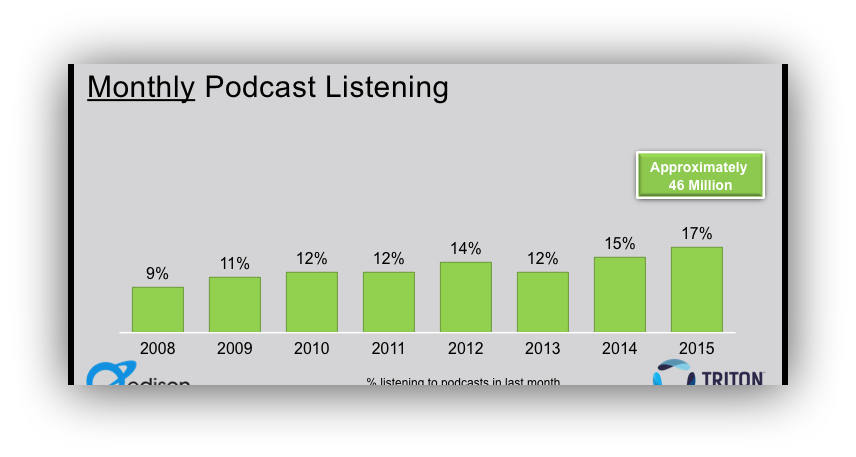
Source: Edison Research
I remember the first time I met one of my favorite podcasters. I sheepishly approached him and introduced myself.
He responded “Whatsup, nice to meet you!”
I was shocked. “He’s just a normal human!” I thought.
Something about the podcast medium though made him both feel authoritative, probably because you used to have to be an authority to start a podcast (when they were called radio) and our perceptions haven’t caught up.
3. Podcasts have higher conversion rates
When I recently launched my book, I went on a podcast that had a readership of around ten thousand people the day after I had a guest post go live on a site that had around ten thousand readers. I sold almost five times as many books the day the podcast went live.
Why do podcasts drive higher conversion rates?
First, listening to someone on a podcast forms a much more personal relationship than reading an article they wrote.
Second, it’s more difficult to skim podcast in the way you can skim an article and so they’re going to hear the full story behind you and your business, not just the headlines.
4. Podcasts are more time efficient
It’s also a much more leveraged use of scarce marketing time for a small business or startup. If you’re focused on growing your business, writing articles for other sites can be time consuming.
A good article usually takes at least five hours to write and edit, and a great longform article like the kind featured on Sumo takes at least ten and sometimes twenty hours.
An hour long podcast on the other hand only takes an hour. If you add on two more hours (one for research and one for prep), it’s still only three hours vs ten.
Add in the conversion rate multiple (we’ll say 2x instead of 5x to be conservative), and you’re looking at a 667% difference.
Author, speaker and consultant Dorie Clark did over 150 podcast appearances in 2015, the year her most recent book Stand Out was released, and also said it was her number 1 channel for driving book sales.
So there’s a distribution channel which is rapidly growing, highly converting and requires less time and resources than others that are already proven to be profitable. Gold mine!
But wait, there’s MOAR
While the immediate benefits are worth it alone, another long term benefit will is the boost to your SEO. Because the podcast host will set up a show page linking to your website, you’ll have a diversified backlink profile from authoritative in your industry. That looks pretty sweet to those Google ranking bots.
I haven’t even mentioned the number one long-term benefit, it’s a great way to build relationships with influencers in your industry. Just as hearing your voice lets you build a deeper relationship with the audience, talking on the phone for an hour lets you build a deeper relationship with the host. Short of meeting in person, hosting a podcast and bringing people on or appearing on someone else’s podcast is the best way to get to know people. You get to talk for an hour in a way that mutually benefits both of you. The host gets a valuable piece of content to share with their audience and you get exposure to a new group
You also can bet pretty safely that these people are going somewhere. They’ve taken the initiative to start a podcast and as Book-in-a-Box founder Tucker Max has said “don’t look for talent, find people who do things.”
So how do you get featured on podcasts?
We’re going to cover:
- 5 steps to getting consistently invited onto podcasts
- A 3 step checklist on how to give a podcast interview
- How to promote the show so the host is dying to have you back on
5 Steps to consistently getting featured on podcasts
1. Build a list of podcast targets
The first thing you need to do is to figure out which podcasts would be a good fit. Use the following method to build a spreadsheet of targets:
Step 1: Do you know anyone that has a podcast? A friend of a friend? Introductions will convert much better than cold pitches.
Once you’ve been on a few podcasts, it only gets easier to be on other because you’re already vetted and tested as a podcast guest.
Step 2: Look for podcasts similar people have been on – Who is an authority in your space that is a few years ahead of where you are?
Make a list of five to ten people who you overlap with and search their names on the iTunes store. All the podcasts they’ve appeared on have a track record of having guests very similar to you! That’s a good sign that they would be willing to have you on.
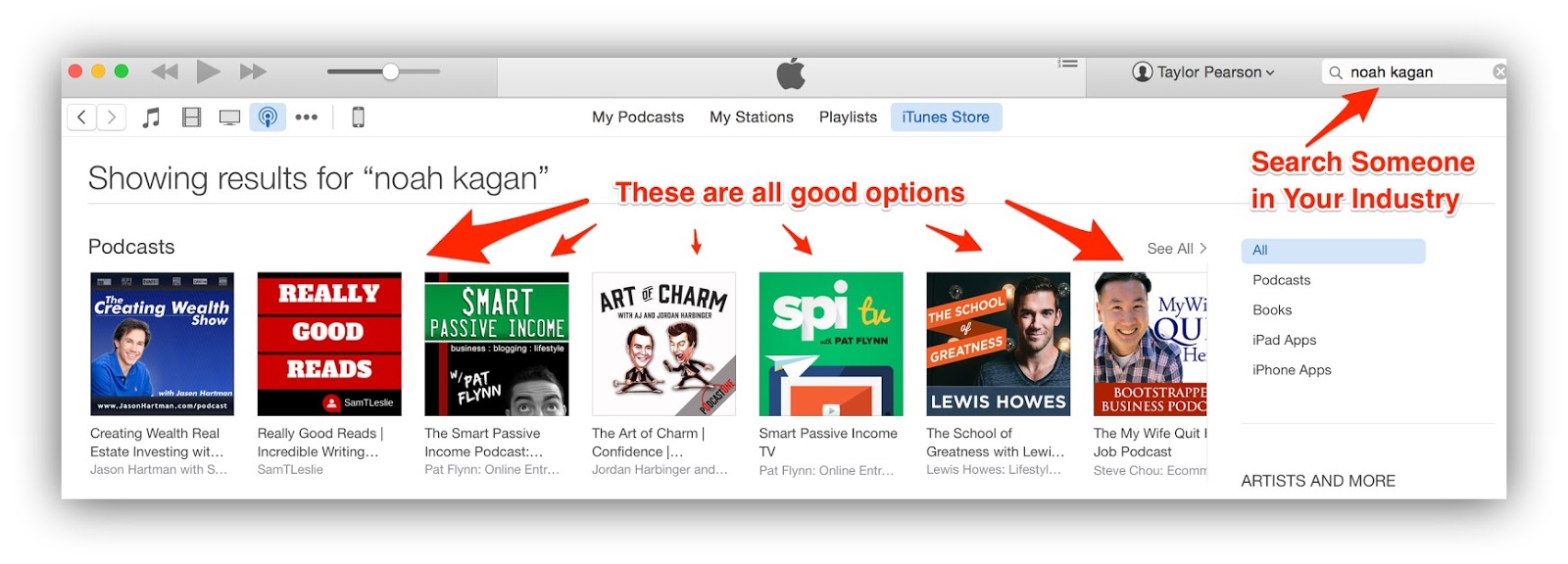
Step 3: Look for Relevant New and Noteworthy Podcasts in iTunes – podcasts that are in new and noteworthy have two very promising attributes:
- They’re new and so they NEED more guests to put out more episodes
- They’re good marketers – if they got into new and noteworthy then they are probably good marketers which bodes well for the future success of their show and your interview.
If you appear on one of the early episodes, when people go download their whole back catalog three years into the future, they’ll listen to your episode. I’ve talked to people that were early guests on Jon Lee Dumas’s Entrepreneur on Fire Show and three years later they still get a steady flow of traffic from it.
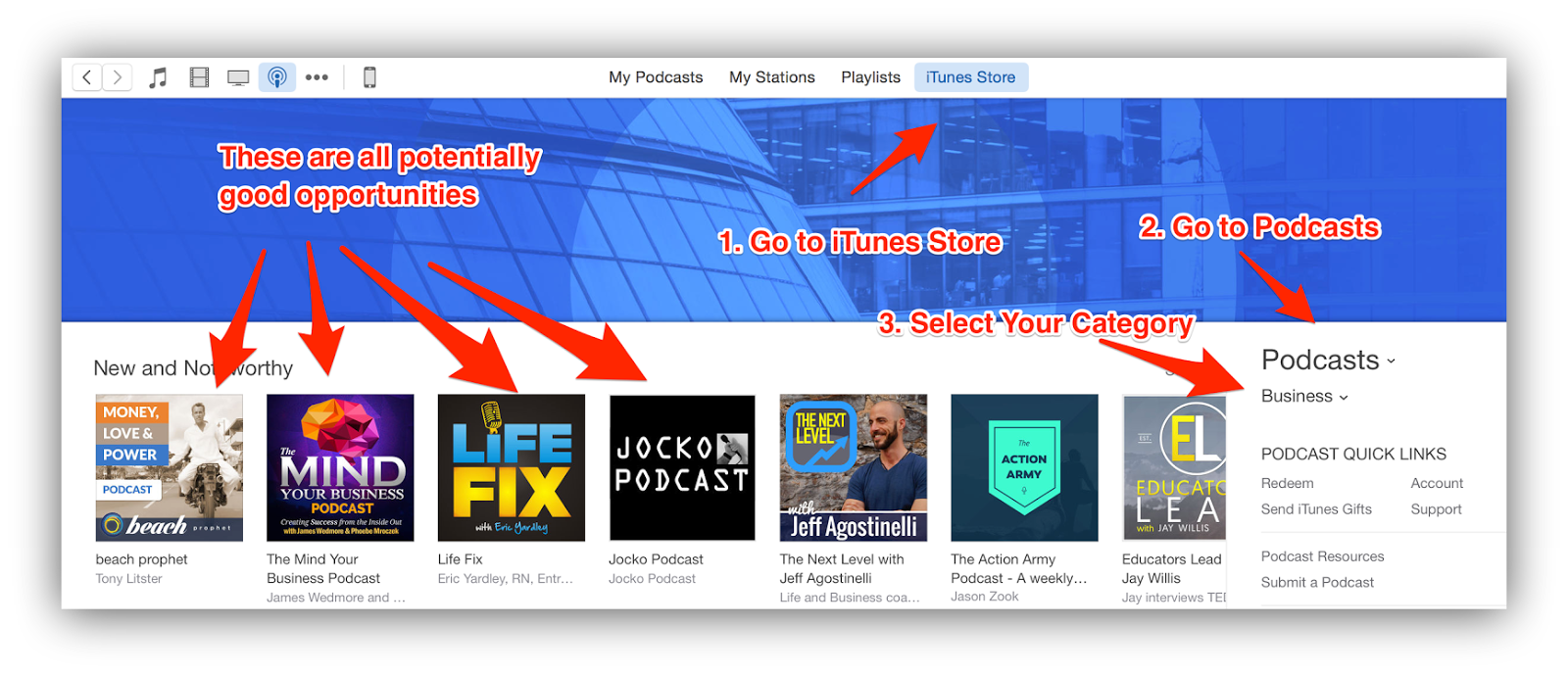
Step 4: Go to Amazon Author pages and see which authors have books on your topic.
Because authors do a lot of podcasts, you can find authors who have books on similar topics to your business and use step 1 again to reverse engineer what podcasts they’ve been on by searching their name in the iTunes store
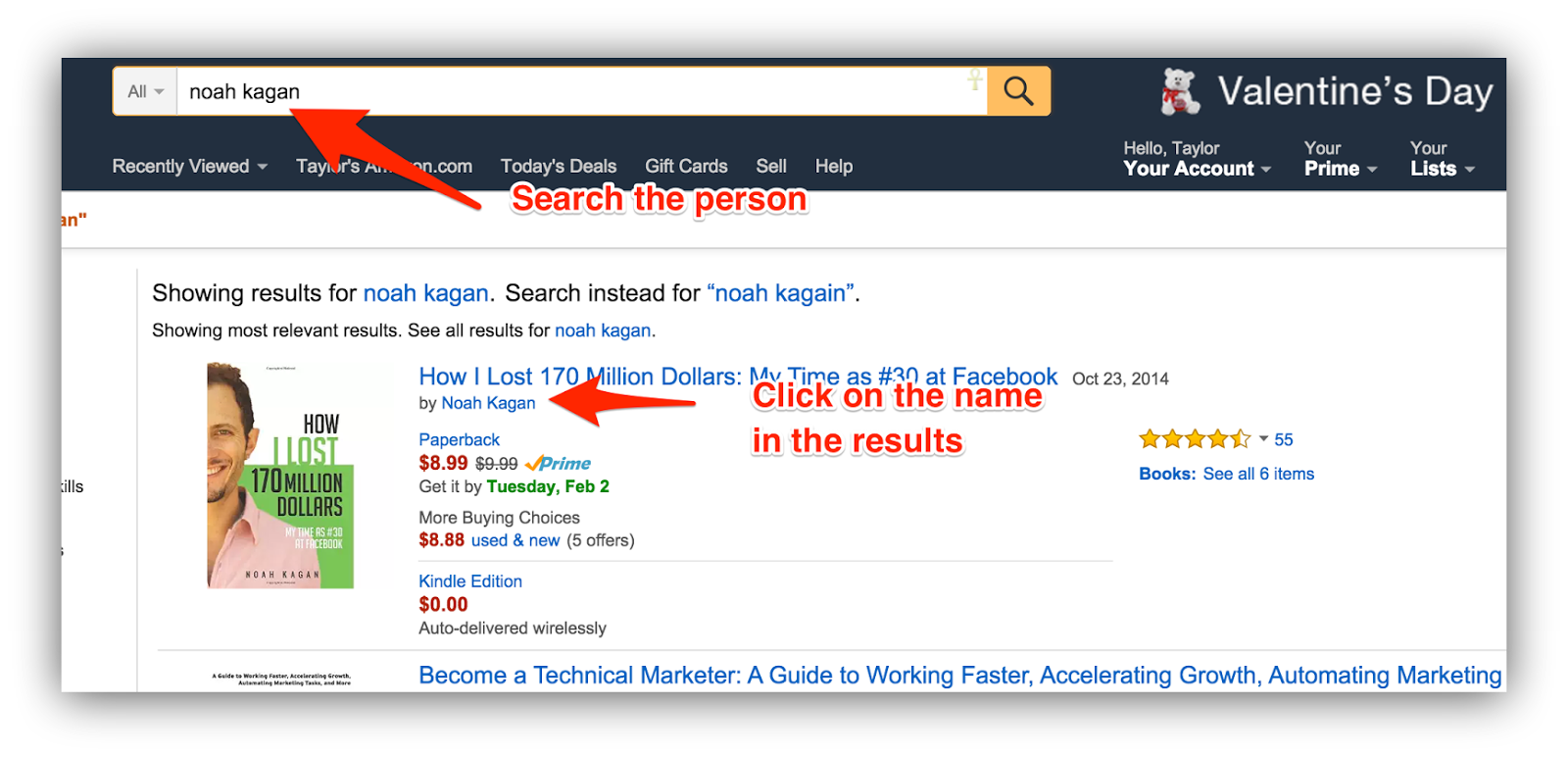

2. Prioritize the list
Now you should have a pretty healthy list of options in your spreadsheet, let’s prioritize.
Step 1: Eliminate – first let’s get rid of all the people that won’t help you grow your business.
Here are characteristics of a good outreach target. If a podcast doesn’t match these, toss them out:
- Have published an episode in the last month and appear to be continuing to do so regularly
- Good brand match – Get rid of anything which reeks of scammy make money online pyramid schemes (unless you’re a scammy make money online person ;))
- They do interviews – some podcasts are solo podcasts where the podcaster gives their opinion on a topic or reads quotes. Make sure they actually have had guests on in the past!
Step 2: Prioritize
Once someone looks like a good match, fill out all a spreadsheet with all the following information about them:
- URL
- Email address (If you can’t find their email, add the contact page URL)
- Twitter Handle
- Estimated degrees of separation from you – Do you know them? Do you know someone who knows them? Use Linkedin and Facebook to determine how many degrees of separation they are for you. I use 1-3 and 4 to represent anything more than 3.
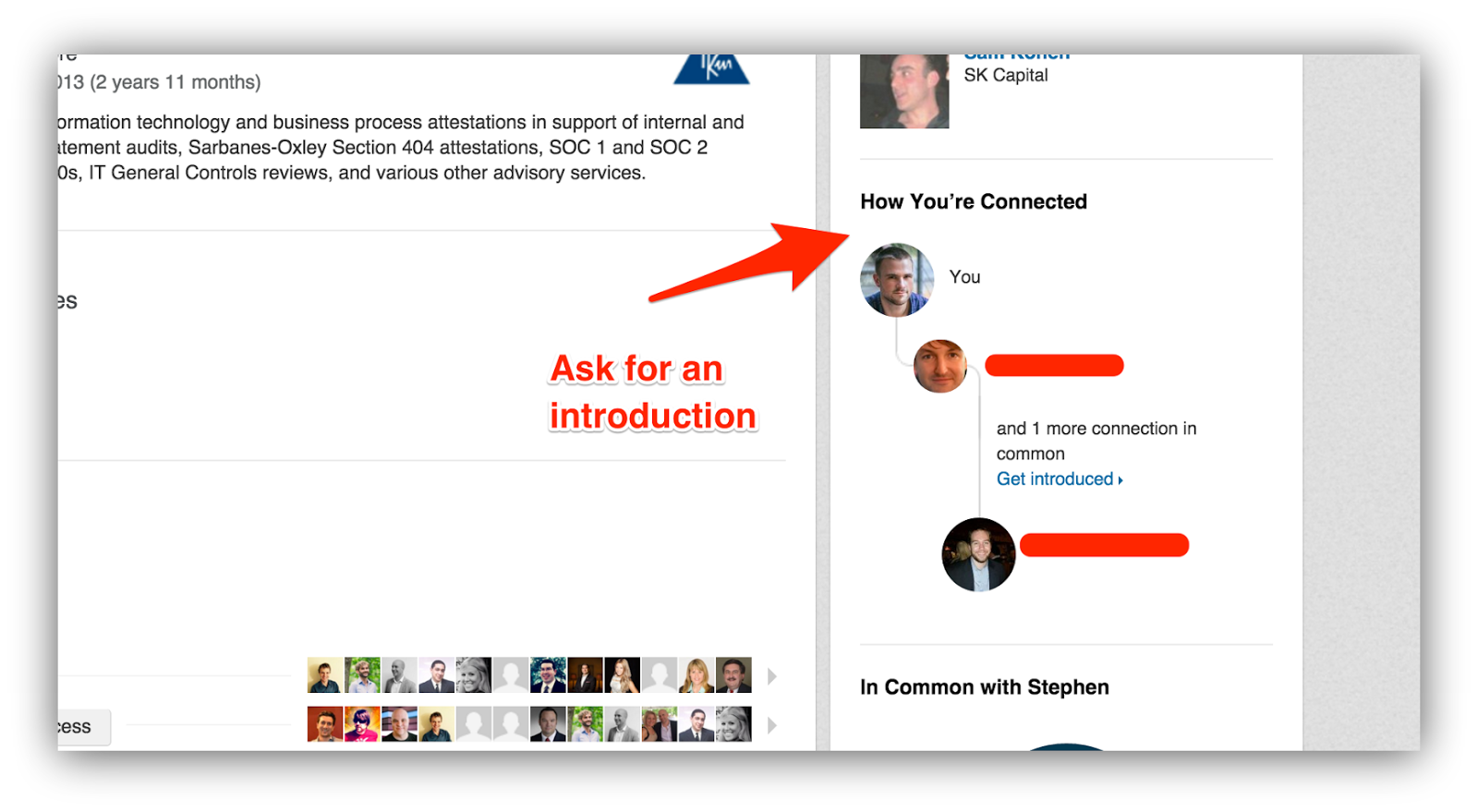
- Expected Reach of their podcast – How big is their podcast? It’s very hard to know podcast reach even for podcasters themselves and most don’t share their numbers. I make an estimated guess using the following order of magnitude rankings based on how many Twitter Followers they have:
- H = Huge = 100k+ Followers
- L = Large = 10K+ Followers
- M = Medium = 1k+ Followers
- S = Getting Started = less than 1k followers
- Where you found them – Make any notes about how you found them to use when you reach out. Did they have a guest similar to you on their podcast? Do you have a first or second degree connection in common that you can ask for an introduction?
Once you’re done for a round of adding prospects, sort the spreadsheet by:
- Degrees of separation
- Estimated reach
Start with people 1 degree of separation at largest to smallest reach then move to 2 degrees of separation largest to smallest reach. How well you’re connected to them and how well your subject fits their podcast is the number one determinant of if they’ll have you on so you’re better off focusing on people you are close to than people with big audiences (If you can get both, kudos!)
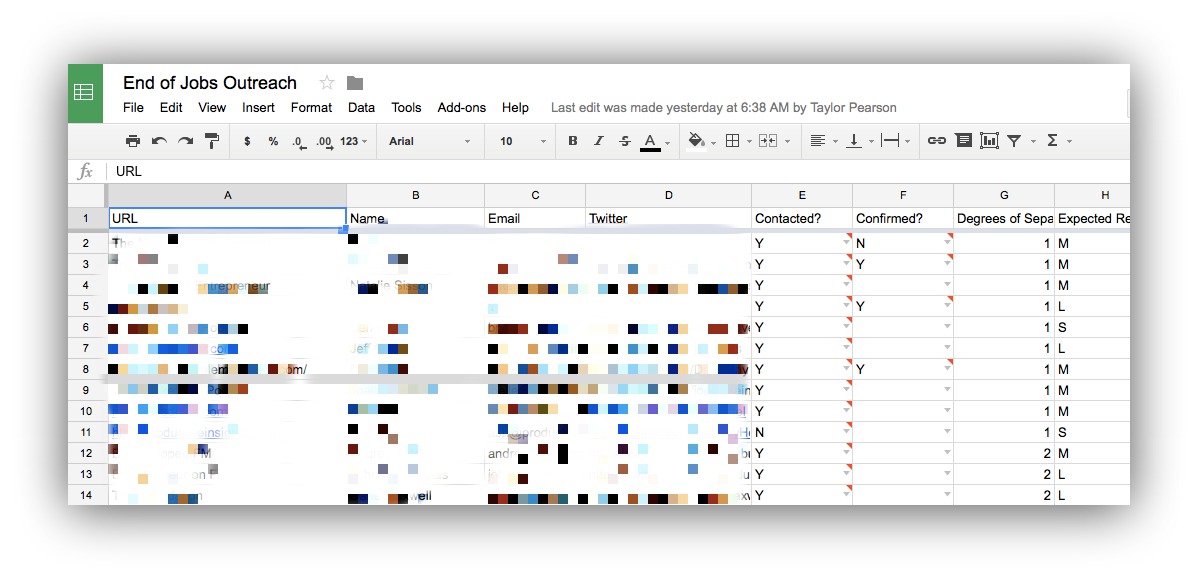
Get the outreach spreadsheet and pitch templates
3. Pitch
For each prospect URL that hasn’t been contacted yet
Look through their Website/Twitter/LinkedIn and…
- Read their about page – what do they have in common with you that could be a personal note?
- Listen to a popular episode of their podcast – get a feel.
- Come up with an angle to email for them – One of the hardest things podcasts have to do is figure out the angle of each show. How will they make this guest uniquely interesting and compelling to their audience? I know podcasters that spend hours preparing for each interview. If you do this work for them and explain why you can deliver a ton of value to their audience, they’re much more likely to have you on. This should be something that can be inserted into the email template below
Make a list of topics you can speak about. Here are the ones I focus on:
- Self-publishing
- Book Marketing
- Writing/creative process
- Reading Books
- Habits/Daily Rituals
- Productivity
- Business Systems
- The End of Jobs and changing nature of work
- Masterminds
Topics can also be “sliced off” of your main subject to apply to adjacent industries for example, habits could be applied to fitness – “Why it’s easier to go to the gym everyday”
Typically, I will tailor the amount of work done on each pitch to the size of the audience.
If they have a huge audience, I will invest more time in crafting a very detailed and specific pitch (I may spend an hour or two on the email pitch alone). If they have a smaller audience, I’ll typically do something a bit more basic and only spend 15 or 30 minutes.
Now you know the angle so it’s time to craft the email.
First, write a good subject line and first two sentences.
The host is probably reading your email between fifty others so you want the first two sentences to stop them dead.
I use my book title “the end of jobs” with a question mark as the subject line because it’s intriguing enough that most people click.
Here’s an example of what it looks like in practice (you can download this template below).
Subject: The end of jobs?
Body:
Hey Justin,
My name is Taylor Pearson. I just published my first book, The End of Jobs. It was a #1 Business Bestseller on Amazon, Inc called it one of the top three Start Your Own Business Books of 2015, and James Altucher said of it: “Entrepreneurship is not a choice you can make at your leisure. You have to jump on the train or lose your chance. Now is the time and Taylor’s book describes exactly how to do it.” (Not an attempt to be braggadocios, just to quickly establish credibility!)
I'm contacting you because I think the book would be interesting for your audience and I'm hoping you would be interested in having me as a guest on your podcast. Here’s an idea for a show that I came up with for your audience:
Why Today Is The Best Day Ever to Be An Entrepreneur
Why Entrepreneurship is More Valuable Than Ever – If you look at any broker business the bottleneck is pretty much always sellers – why? Because the scarce resource is entrepreneurship and people that can build scalable, salable businesses have a huge leverage point.
Why Entrepreneurship is More Accessible Than Ever – Because of the internet, opportunities like niche sites or products, mean that you can learn entrepreneurial skills on the cheap. You don't have to open a store on Main St. and quit your job, you can "dip your toes in." I don't think I've ever told you this, but I emailed you back in early 2012 when I was reading your blog with some super-n00b question (just dug it up and will forward it to you for your amusement :). After you sent me a really kind reply, I started building niche sites about kitchen furniture which I used to get SEO chops and showed to a local marketing agency to get an internship, which turned into a PM role, which turned into my TMBA gig.
Paths into Entrepreneurship – Three clear pathways for people in jobs to get into the game are: apprenticeships, buying a business, or starting a small sides project (stair stepping). We could talk a little bit about each of these and how you guys have used them, and seen other people use them.
If you're interested in having me on, I've provided some information on the book below and would be happy to send you a copy.
If not, no worries whatsoever and thanks for taking the time to put out your show. I just listened to the episode you guys did on “Lifestyle Larry” and lol’d the whole time, I know that guy!
Bests, Taylor
1 Minute Book Summary
Title: The End of Jobs: Money, Meaning and Freedom without the 9-to-5.
One sentence Summary: Jobs are getting more competitive and less profitable while entrepreneurship is more accessible, safer and profitable than ever.
It's different than other books on the subject because it makes that case that Entrepreneurship is a logical, smart decision based on data and research as opposed to just a "follow your passion" one.
I.e. If you're ambitious the shifting macroeconomic situation is such that you're better off being an entrepreneur.
You can download the .mobi file here. (make this a public dropbox link) You can download the pdf here. (make this a public dropbox link)
Important: Always give them an easy out, not the hard sell – I always make sure to give people an easy out “if it’s not a good fit.”
A lot of places that you think are good fits won’t be for many legitimate reasons. Always remember, the relationship is the biggest asset.
4. Confirm the time
Once someone says yes, you want to get a time confirmed to record right away. Again, think about making it easy for them.
Here’s an email example:
Awesome! Looking forward to it!
How about Thursday at 2pm EST? If that’s not a good time, I’m free from 2-6pm Thursday and Friday next week. If none of those times work, my availability is available at [Insert A Calendar Link like ScheduleOnce or Calendly]. Also happy to book on your calendar if you have preferred recording times.
5. Treat it like a sale
Copywriter Dan Kennedy used to spend the first hour of every morning doing sales. Even if he was loaded to the gills with clients, he still spent an hour doing sales because it let him operate with a sense of confidence knowing his pipeline was always full.
If a client was giving him trouble unfairly, he could always say “If this isn’t a good fit, I’m happy to end the engagement” because he knew that he had a line out the door behind them.
You should treat approaching the podcasts the same way if you want to make it a consistent marketing channel. Approaching it like sales also lets you know that:
- It’s ok to have low conversion rates (Average reply rates on cold email is 1-3%, 5-7% is legendary)
- It’s something you need to consistently
- Always start with your hottest leads (those closest to the bottom of the funnel) and work your way back up the funnel toward cold leads.
I’ll spend a few hours per week working my way from the bottom of the funnel up. Here’s how I prioritize the funnel:
- Do a Podcast if one is scheduled 2 Promote any podcast interviews that went live and follow-up with them to say thanks and ask if they know of anyone else.
- Follow-up with anyone that has expressed interest but you haven’t confirmed a date to see if they need anything else from you to help with the show.
- Approach more podcasts using Step 3
- Prospect and Prioritize new podcasts using Step 1 and 2
How to give a good podcast interview

Credit: Jack M. (Flickr)
1. Initial Prep (Do this at least 24 hours in advance)
-
Listen to (a) previous episode(s) – ask yourself “how can I be so good that my interview will still be featured under the top 5 interviews in the sidebar a year from now.” If you benchmark yourself of that, at the very worst you will still be one of the better guests. If you do deliver one of the best episodes, you may stay in their “best of” list for years.
-
Ask if you can have the questions in advance and write out the answer – If the podcast has pre-set questions or the podcaster prepares custom questions for each show, ask if you can have them in advance. I usually ask if I can have the questions an hour before we record and then spend an hour thinking about how I can give answers that will best fit their audience. If they prefer to do it free flow and don’t have preset questions, ask who their listener avatar is. The way you talk to a mostly female audience in their 20’s is different than a mostly male audience in their 40’s.
2. Pre-Interview Prep for Skype (At least 15 minutes in advance)
Step 1: Confirm you are connected on Skype
Step 2: Make sure you can be at a quiet location w/ carpet floors and a solid internet connection – small spaces with carpet are the best for recording, large spaces with hard floors echo more.
Step 3: Use speedtest.net to confirm that your Internet is speedy (At least 2 up, 2 down)
- Disable any apps that slow down connection by running in the background (Excess chrome tabs and dropbox syncing are the most common)
- Disable or mute anything with notifications (slack and cell phone are the most common)
Step 4: Confirm USB Mic is plugged in
If you are planning on doing podcast interviews, the biggest upgrade you can make is getting a decent USB mic. Podcast expert and host of Cashflow Podcast, Ben Krueger, recommends the ATR 2100 as the best value mic. It sounds almost as good as the $250 options and it’s usually around $50 on Amazon.
- Confirm mic is turned n
- Headphones should be plugged into mic
- Mic is close to your face, speak directly into the mic
Step 5: Go to your computer system preferences → confirm your sound input and output are set to USB mic
Step 6: Open Skype
- If you’re out of the country, make sure there is enough credit on your account.
- Set your Skype status to do not disturb.
- Go to Preferences then Audio Video. Set Input to USB Mic, and set Outputs to USB Mic
Step 7: If you made notes for the show based on their questions, pull them up on your computer and read through them
Step 8: Eliminate Background Noise
- Make sure the air conditioning and any other appliances in the room (particularly a fridge) are turned off as they’ll produce an annoying humming noise in the background
- Setup Mic away from computer to avoid computer fan noise
- Try to record on a bed or put the mic on something that absorbs sound like a blanket
- Put Do Not Disturb sign on door if there’s a chance someone will interrupt you
Step 9: Prepare Physically
- Go to the bathroom
- Sit up straight and erect or, if possible, stand
- Take 5 deep breaths from the diaphragm
Step 10: Dial host on Skype
3. All Star Interview Techniques
Getting on podcasts is great, but it’s only part of the battle. If you want podcasts to be an effective marketing channel, you need to deliver a killer interview. Most podcasts I listen to go in one ear and out the other, but there are some podcast episodes that I listen to over and over and stick in my mind years later.
-
Tell stories – Every answer you give should have a story. People learn not through facts, but through stories, analogies and metaphors. Think how you can tell a story or give an example that will answer any question they ask.
-
Speak Deep and Slow from the Belly – When you find yourself going too fast think, about lowering the pitch of voice. If you lower your voice, it will automatically slow you down.
-
Speak Decisively – Don’t say Umm or So or “Kind of” or stutter/repeat yourself, If you don’t know what to say, just be silent then speak when you’ve composed your thoughts.
-
Set up a custom landing page for their audience with freebies – Whatever lead magnet you are using on your website, set it up as a freebie and offer it to their audience using an easy to remember URL. (Note: make sure it’s ok with the host that you do this). I use http://eojbook.com/ to direct people to a landing page where they can download the first three chapters of the book and a list of tools.

If you have an easy to remember URL, you can also create a landing page on your site for each podcast like James Clear does. Here’s the page he directed people to after his Art of Charm interview:
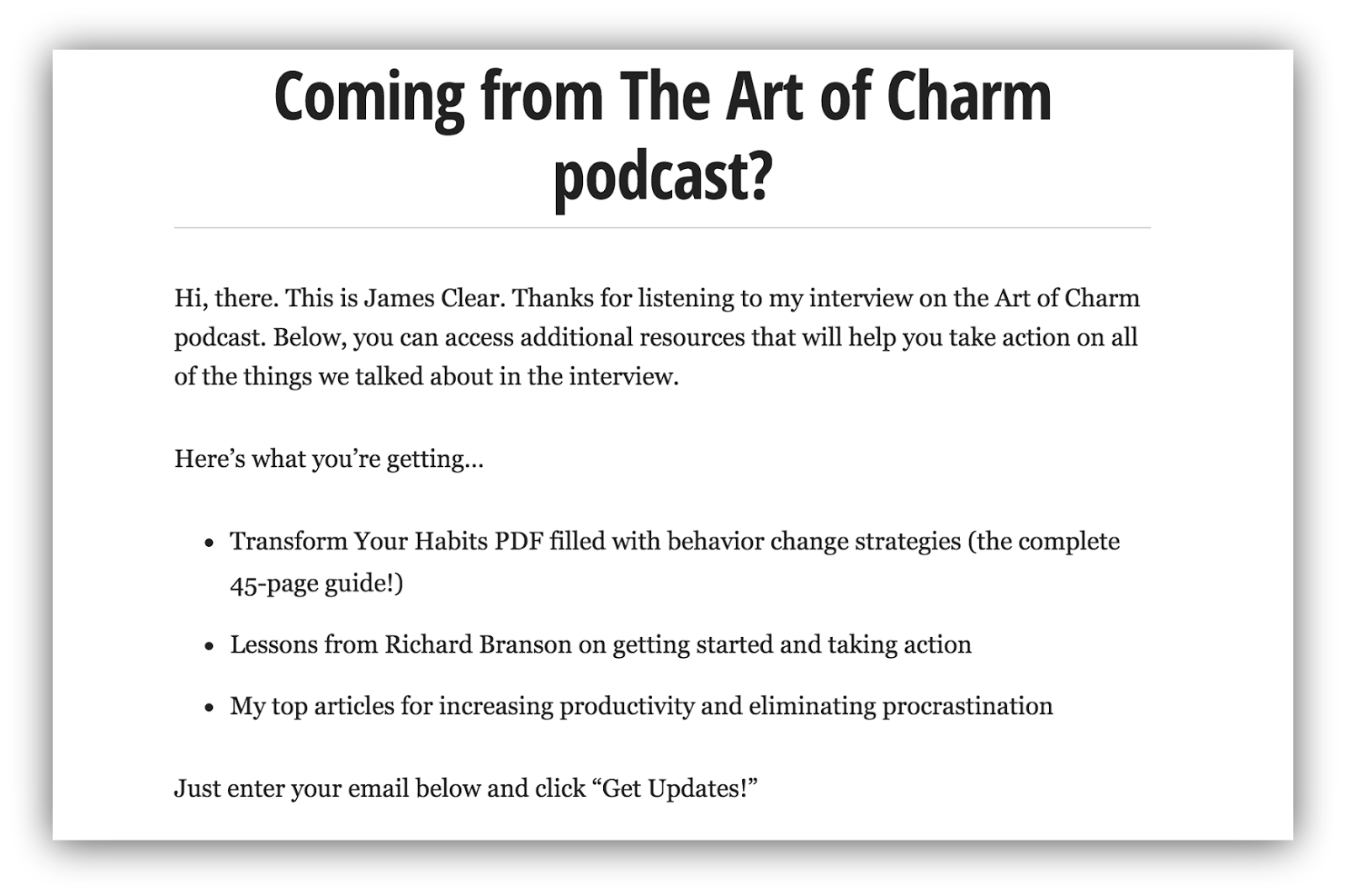
When the podcast goes live
Promote it
Once the podcast goes live, share it on all your social media outlets. It will make you look good to your audience by offering them more content that they might be interested in, and the host will appreciate people you know being exposed to their podcast.
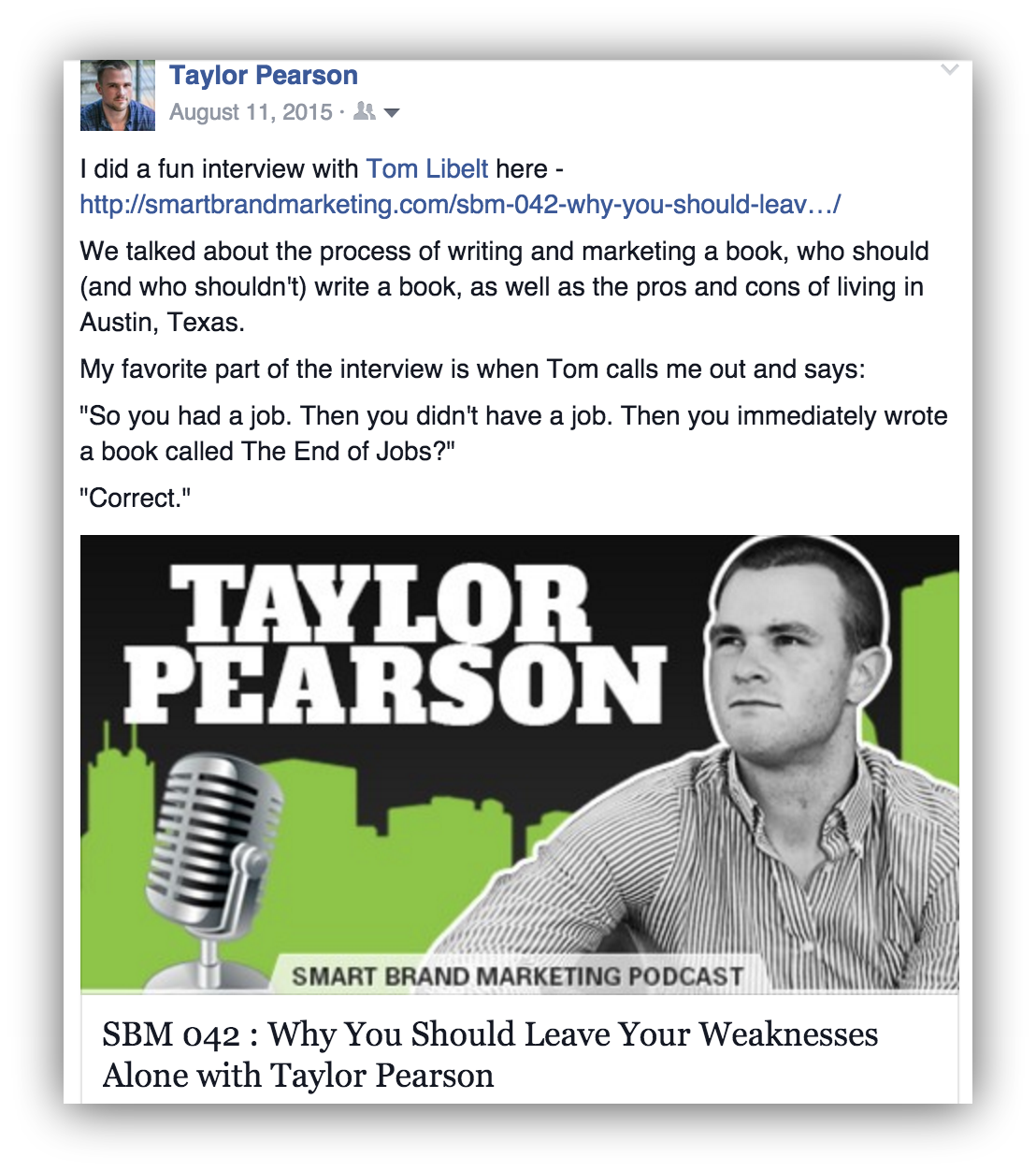
Follow up
Last but not least, thank the host again for having you on and ask if they know anyone else that would be interested.
If you’ve done all the steps above, you’re probably one of the better guests they’ve ever had. Since they’re a podcaster, they probably know other podcasters who might be interested.
Add them to your list and the whole process begins again!
A rising tide lifts all boats and podcasts as a marketing channel are in the early growth stages in most industries. If you’re going to jump on the boat, now is the time.
Hit the ground running by downloading your own copy of the templates mentioned above.








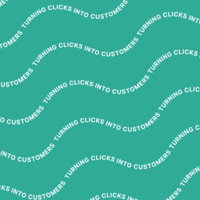

Add A Comment
VIEW THE COMMENTS